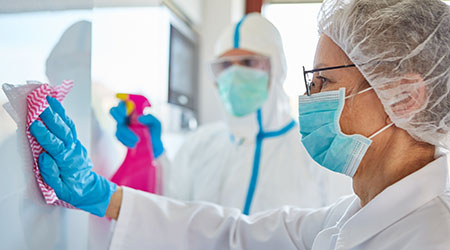Cleaning staff blend into the background on a busy floor where patients are being attended to by nurses. Although they go about their duties generally unnoticed, their work is hardly unimportant. Keeping the hospital clean is a heavy responsibility. It is, in fact, essential in continuing to fight against hospital acquired infections.
Patients and their visitors make comments about hospitals they consider “dirty” and will associate this with a general lack of care. That is why the environment should not only be microbially “fit for purpose,” it should be clean enough not to cause concern to patients.
The place of hygienic cleaning within a hospital is important, especially regarding how the EVS department works together with the Infection Prevention/Control service. Infection prevention does not rely solely on the Environmental Services Associate (ESA). Nursing assistants are generally responsible for processing patient care equipment and the ESA for housekeeping surfaces, but often respective tasks are not clearly defined. For example, if who needs to clean the bedside commode on a daily basis is not explicitly stated, then there is a good chance that that commode may not be cleaned by anyone. In the meantime, the patient and their family members are evaluating the hospital’s cleaning practices.
Clearly define responsibilities for the hygienic cleaning of noncritical equipment, shared medical equipment, and other electronics (e.g., ICU monitors, ventilator surfaces, barcode scanners, point-of-care devices, mobile workstations, code carts, airway boxes).
Make sure that staff involved in hygienic cleaning are aware of their responsibilities and are appropriately trained to fulfill them.
Make sure that cleaning and disinfection supplies are easily accessible (e.g., cleaning cart and patient-care areas are adequately stocked).
Extra support is needed from the nurses. If nurses believe in the original Florence Nightingale definitions of nursing, they should take an active interest in the cleanliness of the patient’s environment and campaign in support of hygienically clean hospitals. Significant improvements could be made if more nurses would take responsibility for the cleanliness and hygienic standards on their own assigned patients.
Effective cleaning is hard work. Contamination is important in a hospital, and cleaning is a valuable way of dealing with it. Environmental Services leaders and trainers must be able to create an environment where the associates are engaged. An unengaged employee is a risk to the health and safety of patients and hospital staff. An informed person tends to be more compliant, and a compliant person is more engaged. Engaged teams are more efficient and more aware, and individuals need to understand that everyone’s work is important.
It is important to realize that the best product, equipment, or intervention is worthless without the right education program, the right tools, the right processes, and an engaged ESA.
Remember, one engaged, educated and trained Environmental Services Associate given the right tools to do their job, and allotted the time to do the necessary tasks will prevent more infections than a room full of doctors can cure.
J. Darrel Hicks, BA, MESRE, CHESP, Certificate of Mastery in Infection Prevention is the Past President of the Healthcare Surfaces Institute. Hicks is nationally recognized as a subject matter expert in infection prevention and control as it relates to cleaning. He is the owner/principal of Safe, Clean and Disinfected. His enterprise specializes in B2B consulting, webinar presentations, seminars and facility consulting services related to cleaning and disinfection. He can be reached at darrel@darrelhicks.com or you can learn more at www.darrelhicks.com.

 Design Plays a Role in the Future of Healthcare
Design Plays a Role in the Future of Healthcare Cedar Hill Regional Medical Center GW Health Officially Opens
Cedar Hill Regional Medical Center GW Health Officially Opens Designing Healthcare Facilities for Pediatric and Geriatric Populations
Designing Healthcare Facilities for Pediatric and Geriatric Populations Kaiser Permanente Announces New Hospital Tower at Sunnyside Medical Center
Kaiser Permanente Announces New Hospital Tower at Sunnyside Medical Center Building Disaster Resilience Through Collaboration
Building Disaster Resilience Through Collaboration